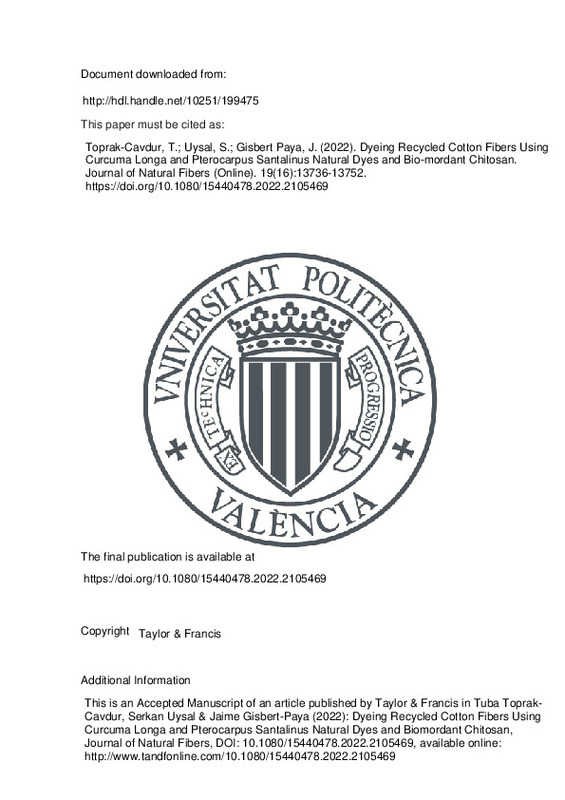JavaScript is disabled for your browser. Some features of this site may not work without it.
Buscar en RiuNet
Listar
Mi cuenta
Estadísticas
Ayuda RiuNet
Admin. UPV
Dyeing Recycled Cotton Fibers Using Curcuma Longa and Pterocarpus Santalinus Natural Dyes and Bio-mordant Chitosan
Mostrar el registro sencillo del ítem
Ficheros en el ítem
| dc.contributor.author | Toprak-Cavdur, Tuba
|
es_ES |
| dc.contributor.author | Uysal, Serkan
|
es_ES |
| dc.contributor.author | Gisbert Paya, Jaime
|
es_ES |
| dc.date.accessioned | 2023-11-09T19:01:53Z | |
| dc.date.available | 2023-11-09T19:01:53Z | |
| dc.date.issued | 2022-11-28 | es_ES |
| dc.identifier.uri | http://hdl.handle.net/10251/199475 | |
| dc.description | This is an Accepted Manuscript of an article published by Taylor & Francis in Tuba Toprak-Cavdur, Serkan Uysal & Jaime Gisbert-Paya (2022): Dyeing Recycled Cotton Fibers Using Curcuma Longa and Pterocarpus Santalinus Natural Dyes and Biomordant Chitosan, Journal of Natural Fibers, DOI: 10.1080/15440478.2022.2105469, available online: http://www.tandfonline.com/10.1080/15440478.2022.2105469 | es_ES |
| dc.description.abstract | [EN] Problems such as the depletion of natural resources and the increase in envir-onmental pollution brought about by industrialization, the concept of recycling gained great importance. Natural dyes have gained importance again with the increase in environmental awareness. For this purpose, the dyeability of recycled cotton yarns with natural dyes was examined in order to both protect natural resources and reduce the waste water load in dyeing. The paper also discussed a comparison between different ways to mordant cotton with different mole-cular weight chitosan. Although it was seen by FTIR analysis that cotton fibers were dyed, the presence of chitosan could not be clearly seen. It was explained by the use of low amounts of chitosan. It was observed that the mordanting processes performed with chitosan contributed to the increase in the color strengths, and higher color depths were obtained with the increasing chitosan concentration. Simultaneous mordanting in Curcuma longa dyeing, mordanting before Sandalwood dyeing provided higher color depths than others. The washing fastness of the samples dyed with Curcuma longa revealed the neces-sity of fastness improvement processes. It was concluded that chitosan mordant-ing process was effective in terms of sustainable natural dyeing, but it was necessary to improve fastness. | es_ES |
| dc.language | Inglés | es_ES |
| dc.publisher | Taylor & Francis | es_ES |
| dc.relation.ispartof | Journal of Natural Fibers (Online) | es_ES |
| dc.rights | Reconocimiento - No comercial (by-nc) | es_ES |
| dc.subject | Sustainability | es_ES |
| dc.subject | Turmeric | es_ES |
| dc.subject | Sandalwood | es_ES |
| dc.subject | FTIR | es_ES |
| dc.subject | K/S | es_ES |
| dc.subject | Fastness | es_ES |
| dc.subject.classification | INGENIERIA TEXTIL Y PAPELERA | es_ES |
| dc.title | Dyeing Recycled Cotton Fibers Using Curcuma Longa and Pterocarpus Santalinus Natural Dyes and Bio-mordant Chitosan | es_ES |
| dc.type | Artículo | es_ES |
| dc.identifier.doi | 10.1080/15440478.2022.2105469 | es_ES |
| dc.rights.accessRights | Abierto | es_ES |
| dc.contributor.affiliation | Universitat Politècnica de València. Escuela Politécnica Superior de Alcoy - Escola Politècnica Superior d'Alcoi | es_ES |
| dc.description.bibliographicCitation | Toprak-Cavdur, T.; Uysal, S.; Gisbert Paya, J. (2022). Dyeing Recycled Cotton Fibers Using Curcuma Longa and Pterocarpus Santalinus Natural Dyes and Bio-mordant Chitosan. Journal of Natural Fibers (Online). 19(16):13736-13752. https://doi.org/10.1080/15440478.2022.2105469 | es_ES |
| dc.description.accrualMethod | S | es_ES |
| dc.relation.publisherversion | https://doi.org/10.1080/15440478.2022.2105469 | es_ES |
| dc.description.upvformatpinicio | 13736 | es_ES |
| dc.description.upvformatpfin | 13752 | es_ES |
| dc.type.version | info:eu-repo/semantics/publishedVersion | es_ES |
| dc.description.volume | 19 | es_ES |
| dc.description.issue | 16 | es_ES |
| dc.identifier.eissn | 1544-046X | es_ES |
| dc.relation.pasarela | S\473637 | es_ES |







![[Cerrado]](/themes/UPV/images/candado.png)

